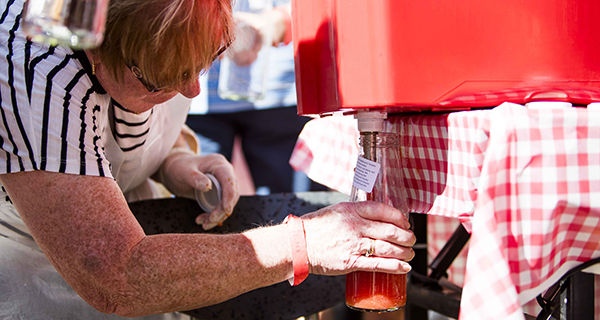
By the end of February, the streets of many suburbs of Melbourne and Sydney are coloured in red, as families and friend gather together to celebrate the old Italian art of making passata, a tomato sauce used mainly to garnish pasta dishes and pizzas. In the beginning, such a tradition was confined to the areas where Italian migrants to Australia first settled: places such as Preston, on the outskirts of Melbourne, and Leichhardt, near Sydney, where the population with an Italian background represents a large majority. Little by little, the concept that passata was a delightful seasoning, to be used in many recipes, overcome the borders of the Italian community. Would of mouth was passed that cooking home-made tomato sauce was not only a way to save money from buying expensive imported products, but also an amusing activity. First, came the Greeks, who started preparing their own passata in their gardens after learning from their Italian neighbours. Then came the others.
IT’S ‘PASSATA’ MANIA – Nowadays, the passata virus has spread and seems uncontrollable. Hipsters and slow-food enthusiasts have embraced a tradition that once appeared to be doomed to be confined among the migrants’ sons and daughters. Not only they make their own passata, but they are ready to spend thousands of dollars to be the first to put their hands on the latest tomato-processing gadgets. Sales of food mills imported from Italy increase every year and unexpected passata-makers show with pride the complex machineries hidden in their garages. As a result, behind piles and piles of bottles filled with tomato sauce, it is now easier to spot the beard-and-tattoo kind of guy, rather than a serene old lady with a traditional scarf around her neck. Associations like the Sydney Youth Food Movement Australia are now equipped with passata-making machines which are regularly used during the events they run.
MELBOURNE TOMATO FESTIVAL – In Melbourne, where the buzz around tomatoes appears to be stronger than in the rest of the country, festivals are organized to provide Italian-Australians and their rivals an arena to compete over who makes the best passata. The most famous is the Melbourne Tomato Festival, which happens on March 1st every year and whose tickets are sold out in a couple of days. Guy Grossi, a world-class chef who has initiated the Melbourne Tomato Festival a few years ago, says that “Passata day is set in the calendar like Christmas and Easter.” Those who cannot get in do not have to despair: they can pick one of the many alternatives, such as the Crowdsaucing, where hundreds of people roll the sleeves and get together to boil and squeeze the best tomatoes of the region. What comes out from these festivals could be hardly distinguished from the passata bottles made by our grandmothers in the South of Italy, if it wasn’t that often the bottles used are those of Calrton Draught, an extremely popular beer in Australian households. The red colour will surely continue to mark Australian lanes and suburban courtyards to get messy with tomatoes for many years to come.

